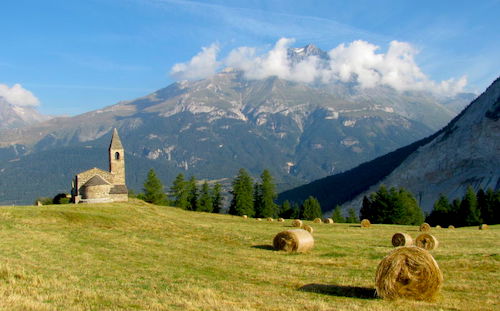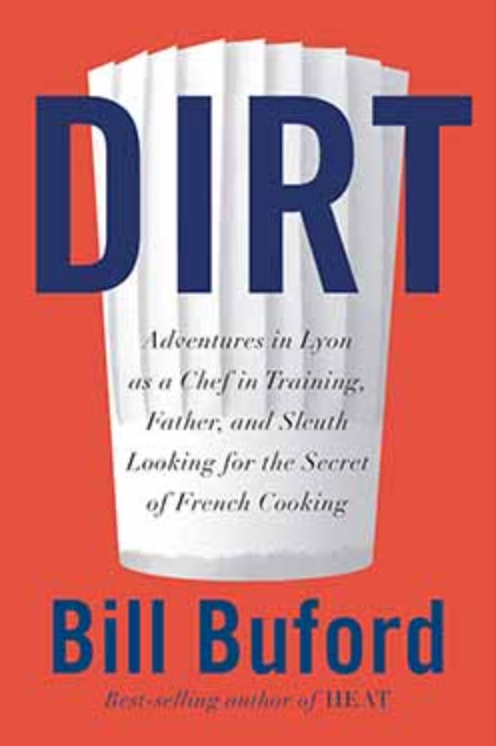
Did the Italians Actually Teach the French the Art of the Vinaigrette?
Bill Buford on the Trail of a Culinary Mystery
At the Renaissance Society of America Conference
The cultural magnificence of the vinaigrette was revealed to me in a paper read by Timothy Tomasik, an accomplished scholar of 16th-century French food, basically 1530 to 1560, during the height of the foires of Lyon and right around the time that the grand councillors of the city hosted their Swiss counterparts. The event, held on a rainy Saturday morning in Manhattan, was moderated by Allen Grieco, a research associate at the Villa i Tatti in Florence, the Harvard Center for Renaissance Studies. (Spoiler alert number five: We did visit New York City—twice; in fact, we would eventually return.) Tomasik’s paper was on the history of the word “vinaigrette.”
Since the withering humiliation of my having to ask how to make a vinaigrette, I had become a student of it and its many variations and its importance to the French kitchen (acid! wine! balance!). But the history? I had read Pasteur, but Pasteur was 19th century. Tomasik, then a friend (we met at another Renaissance food conference), was going to go deep into the word’s very origins. I showed up jumping-in-my-seat excited, and was shocked, genuinely, to see that only six other people were in the audience in a room that accommodated 200. On a Saturday! New York is a big city. Where were everyone?
Tomasik’s lecture was an effort to solve a puzzle. The modern sense of the word “vinaigrette” was first published in the Dictionnaire de l’Académie française in 1694, which describes it as “a type of cold sauce,” une sorte de sauce froide, that is made “with vinegar, oil, salt, pepper, parsley, and chives.” Since then, there have been variations on the essential formula, but the French Academy’s remains the best definition.
But before 1694, it was a meaty sauce. The word first appears in the 14th century, in Taillevent’s Le Viandier, one of the earliest surviving French cookbooks. It is perhaps less French than medieval, illustrated by his instructions for making “une vinaigrette,” for which you start with a pig’s spleen, brown it on a spit, chop it up, add it to a pot with blood, broth, ginger, a pepperlike spice, saffron, wine, and vinegar (finally), and then boil. “It should be brown.”
A sheep-based vinaigrette calls for the head, stomach, and feet. A cow vinaigrette insists on using all four stomachs.
During the Q&A, Tomasik, disarming in his honesty, admitted that his paper (“A Vinaigrette by Any Other Name”) was a work-in-progress.
Culinary historians tend to work in the language of their specialization and rarely venture out of it—the Italians rarely speaking to the French, the French not going out of their way to speak to the Italians.
He had begun, Tomasik said, with what seemed like a straightforward problem of lexicography. In early French history, “vinaigrette” meant something that seemed appropriate for the food eaten at the time— basically, pot-in-a-hearth cooking. By the late 17th century, the word had come to mean something completely different, but was also completely appropriate for the food of its time: a light dressing for comparably lightly cooked vegetables, like haricots verts or artichokes. What he couldn’t find was when the word changed. He had charted its usage in books published in 1536, 1539, 1542, 1547, and 1552. He expected to find something in the subsequent one hundred years, but hadn’t yet.
He had the aw-shucks manner of the good student who had shown up to class with an essential problem in his homework not quite solved but one that he would sort out shortly.
I thought: Not a chance.
Those one hundred years: They represent the dark tunnel in French cooking. At one end, you find the food that you can cook in your fireplace; at the other the end, on or around 1651, when Le Cuisinier françois was published, a radical festival of ostentation and expertise. The book was written by a François Pierre de La Varenne. Though the title is probably a play on words (i.e., either The Cook François or The French Cook), there is no ambiguity in how it was understood and translated. It was a declaration of nationalist cuisine. Le Cuisinier françois said, “This is our food. It is our culture.” In the approximately 400-year span of recipes, manuscripts, translations, and culinary publications of any kind in French, no text had so forthrightly proclaimed its Frenchness. After Le Cuisinier françois, French cuisine was established.
But, in the eyes of many, there is virtually no record of what had been going on to effect the change. Something was happening, obviously (nothing comes from nothing), but who knew what it was?
Meanwhile, I was jumping up and down in my seat. I was very excited. I knew the answer! At least in relation to the vinaigrette! It was on the other side of the Alps, in Italy, a tract about salads, but I couldn’t remember the name of the author, except that it was a quirky name, something like “happiness.”
Grieco, for his part, was also jumping up and down, but he knew the name and had downloaded a text on his phone. The author was Costanzo Felici.
“Yes,” I blurted out. I couldn’t help it. “Felici! That’s the guy!”
Grieco continued. “Costanzo Felici was a medical doctor and a naturalist in the village of Piobbico.” Piobbico is east of Florence and almost to the Adriatic. “He had published tracts on aspects of natural history: the olive tree, the mushroom, the wolf, an agrarian calendar.” Grieco, who was 66 and had a silver goatee and wore round scholarly spectacles halfway down the bridge of his nose, had the manner of a man accustomed to having to speak softly in libraries. Tomasik, half his age, was robustly broad-chested, and youthfully confident. Grieco treated him with careful respect.
Felici fell into a correspondence with one of the great botanists of the time, Ulisse Aldrovandi, at the University of Bologna. Aldrovandi asked Felici to describe the vegetables that were being eaten in his village, especially the salads and herbs, and how they were prepared: something like a field report. They were done in one way, Felici wrote: con olio, aceto, sale, e pepe. With oil, vinegar, salt, and pepper.
After Felici’s death, his letters to Aldrovandi were published as a book. Grieco read a few sentences aloud, a reference to how the Italians had been regarded by the French, as indiscriminate salad eaters: “il cibo dell’insalate—così dette volgarmente, cibo quasi proprio (dicono gl’oltramontani) de’ Italiani ghiotti quali hanno tolta la vivanda agl’animali bruti che si magnano l’herbe crude—.”
I had come upon the passage before, in 2003, in a cultural history of Italian cooking by Alberto Capatti and Massimo Montanari that would be my introduction to the beauty and high achievement of the Italian Renaissance kitchen. The text is now quite famous, if only for its droll wit, including the word, oltramontani, to describe the French: i.e., the people from the other side of the mountains. Those people think we are the crude ones—they think we are the gluttons (ghiotti)—because we take raw grass out of the mouths of brute animals and eat it instead of them! The French, Felici was saying, don’t get it. They are the ghiotti, meat-eaters only, who don’t understand the appeal of salad and vegetables, earth’s bounty, the expression of its seasons. Felici wasn’t to know that it would be only a matter of time.
Is there a paper trail that we can follow that illustrates how the Italians taught the French how to make and dress a salad?
Probably not.
But there is a footpath, seldom mentioned by historians, a mountain trail, and the traffic on it, in food and people and ideas, was steady and busy. It is pre-Roman. It is as old as walking. It begins in Susa, the town the Romans called Segusio, on the northwestern edge of the Italian peninsula, passes through the mountains, and emerges in Le Planay, a village where the French established an early customhouse. It wasn’t the only way between Italy and France, but, in the early 1500s, had become popular enough for the king to see a tax-collecting revenue opportunity. In exchange for paying duties, traders were promised protection on the trail from thieves.
What attracted the Italian traders? The foires, those quarterly markets in Lyon, only recently re-established, and this transalpine trail, sometimes called le chemin du Piémont, led directly to them. Many of the products sold there (spices, silks, mortadella, the suddenly popular “fromage de Milan”—i.e., Parmigiano) were Italian; most of the bankers, importers, and wholesalers (Gadagne, Capponi, Manelli, Grimaldi, Sauli, Johanno, Bonvisi, and Cenami) were of Italian descent. The foires made Lyon prosperous. They also made it into a culinary hothouse; they helped create the cuisine that was developing there.
Vinaigrette worked for a medieval stew. But it is a curiosity of history that when people stopped making the stew there was this great word that an oil-and-vinegar dressing could move into.
Later I traveled to Susa and learned the route has been protected by a customs pact for much longer than I had known. It is commemorated by a stone arch at the start of the trail, agreed between Caesar Augustus and the Celtic tribes of the Alps under King Cottius. The town no longer figures in guidebooks (with the construction of the Fréjus Tunnel, Susa is almost always bypassed), and since the Maastricht Treaty of 1992, the borders have been effectively dissolved, but for me it was an unexpected miracle—to stand there, in front of the portal through which so much has passed, back and forth: hunter-gatherers, soldiers, salt, Hannibal with his elephants, black pepper, the Apostle Paul, Julius Caesar en route to conquering Gaul, Charles VIII hoping to conquer Italy, François Premier (twice), Rabelais, Montaigne, Leonardo da Vinci, manuscripts, merchants, popes, 18 centuries of monks, religious pilgrims, Charlemagne, Italian bankers, the Renaissance, the history of Europe, and, possibly, a salad dressing.
And, thus, this word “vinaigrette”: I think of it like a crustacean’s home, the shell. When its inhabitant dies, another creature moves in. Or like the peasant homes that you see on le chemin du Piémont, built from the stones of older homes that have been abandoned. Vinaigrette worked for a medieval stew. But it is a curiosity of history that when people stopped making the stew there was this great word that an oil-and-vinegar dressing could move into.
Foods are always crossing the globe. The pig, at the heart of the Italian and French diet, came from China. Turkeys, potatoes, tomatoes, squash, and chocolates came from the Native Americans in the New World. The quenelle, famous as a Lyonnais food, came from the Austrian Knödel.
But vinaigrette: This is of a different order. It is not an ingredient. It is a preparation. It is an idea, a way of eating.
I would rarely meet a French person who believed that the Italians had anything to do with the development of French cuisine. A phrase I would hear often was the lack of “preuves incontestables d’Italienités”— the incontestable proof of anything Italian in what became French food.
The evolution of the word “vinaigrette” is not an incontestable proof. But it invites one to consider the limitations that inhibit scholarly investigation. Culinary historians tend to work in the language of their specialization and rarely venture out of it—the Italians rarely speaking to the French, the French not going out of their way to speak to the Italians—none of which is surprising except that, in food matters, the two cultures are complexly connected. Jacqueline Boucher, a professor of 16th-century Lyonnais history, has written the excellent Présence Italienne à Lyon à la Renaissance (The Italian Presence in Lyon During the Renaissance).
In her (admittedly abridged) bibliography, she lists 46 works: 42 of them are in French, two in English, and one in Italian, a genealogy of the Gadagne banking family. How, I can’t help myself from asking, can one write about the Italians without reading what they had to say in their own words? In our time in France, I attended a number of Renaissance food conferences, fascinated by what there was to learn, and, each time, was warned by an organizer: “Watch the Italians and the French—they won’t want to have anything to do with each other.” That big mountain range separating the two countries appears to be much more than a matter of geology.
 A view of Mont Cenis, near the French-Italian border.
A view of Mont Cenis, near the French-Italian border.
That big mountain range itself is also misunderstood, informed by an anachronistic view that, in medieval and Renaissance Europe, a boat was more reliable than travel by foot or by animal, especially if it involved crossing the Alps, which was obviously too arduous for normal people to cross.
Well, it wasn’t, and it isn’t. And, in an era without reliable meteorological forecasting, it was much less dangerous.
I wanted to replicate that crossing, climbing up the steep side, with my young boys: to make the point that if they could do it—in, admittedly, the summer, the most favorable season for an Alpine crossing—so could cooks, artists, poets, architects, princesses, monks with their knowledge of bread and sausage making, painters, and the whole long train of the Italian Renaissance. The trail, I knew, wasn’t in good shape. In 1803, Napoleon changed the route (he found a wider passage, suitable for his armies, that commenced in Lanslebourg, the next town up the valley from Le Planay, and that survives as a paved road, the D1006). After 200 years, the original path is scarcely well maintained. We stayed at Lavis Trafford, the chambre d’hôte built on the premises of the original customhouse, and we tried the trail when the boys were five. In the morning, they walked a mile to the trailhead. There was a sign invoking the centuries of history that had made the ascent. The boys read it and said, “Nah.” They were already exhausted.
We returned when they were seven. Encouraged by Marc Broyer, the Lavis Trafford proprietor, who mischievously described the walk as a “stroll” that wouldn’t “take more than an hour,” the boys and I, dressed in shorts and sandals (I never thought that they would actually reach the top), completed the hike. It took four hours. It wasn’t that far—four miles?—but was steep, and the trail was washed out and rocky (George twisted an ankle, Frederick, terrified of bees, was stung), and we ran out of drinking water before the last challenging ascent. Meanwhile, both boys were being covertly coerced by their father, who promised them that, if they completed the walk, the event would be recorded with their names (George Ely Buford and Frederick Hawkins Buford) in the book he was writing. They considered the offer and concluded, okay, they would press on. When we reached the top, there was running water, a restaurant, and a paved road. But that didn’t matter. Four years later, aged eleven, they did the hike again!
________________________________

From DIRT: Adventures in Lyon as a Chef in Training, Father, and Sleuth Looking for the Secret of French Cooking by Bill Buford. Copyright © 2020 by Bill Buford. Excerpted by permission of Alfred A. Knopf, a division of Penguin Random House LLC. All rights reserved. No part of this excerpt may be reproduced or reprinted without permission in writing from the publisher.
Bill Buford
Bill Buford has been a writer and editor for The New Yorker since 1995. Before that he was the editor of Granta magazine for sixteen years and, in 1989, became the publisher of Granta Books. He is also the author of Among the Thugs (Norton, 1992). He was born in Baton Rouge, Louisiana, grew up in California, and was educated at UC Berkeley and Kings College, Cambridge, where he was awarded a Marshall Scholarship for his work on Shakespeare’s plays and sonnets. He lives in New York City with his wife, Jessica Green, and their two sons.












